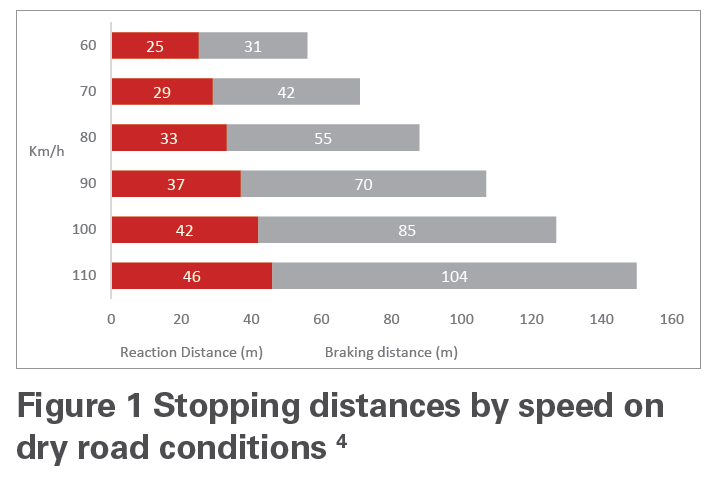Speeding is a major challenge in road safety, largely due to its prevalence as a behaviour. It is estimated that speed-related crashes in New South Wales alone cost the community around $750 million per annum. Speeding remains the greatest cause of death and injuries on Australian roads, contributing to approximately 40% of road fatalities. According to a survey of Australian residents conducted by the Australian Transport Safety Bureau(1):
- 60% of drivers admit to speeding occasionally
- 33% of drivers admitted to exceeding 60km/h limits by 10km/h or more
- 46% of drivers admitted to exceeding 100km/h limits by 10km/h or more
Commercial vehicles are more likely to exceed the speed limit and to be excessively fast in both urban and rural settings than private vehicle drivers. Drivers who are running late are more likely to exceed the speed limit and be excessively fast motorists than all other travel schedule categories.(2) (3)
The leading contributory factor to rear end collisions is driver distraction. A distracted driver takes longer to stop their vehicle as reaction time is increased. Speed is also a major contributing factor with breaking distance increasing exponentially the greater the speed of a vehicle. Amazingly, around 90% of these rear-end collisions and associated injuries could have been avoided with just one extra second of warning time.
There are three types of speeding:
- Excessive – speeding is deliberate and substantially over the speed limit.
- Low level – speeding marginally over the posted speed limit, typically by 5km/h (research shows the majority of motorists engage in low level speeding).
- Inappropriate – travelling at a speed that is inappropriate for the conditions such as travelling at the speed limit when the road is wet.
All of these types of speeding are dangerous. Speeding reduces the time drivers have to avoid crashes, their ability to control the vehicle and lengthens stopping distances, increasing both the likelihood of crashing and the severity of the crash outcome.(3)
Excessive Speed
There are many reasons why higher speed has a major influence on safety:
- greater distance is needed to stop a vehicle in order to avoid a crash
- less time to react to quickly changing road and traffic conditions to make safe decisions
- dangerous situations can arise more easily
- the time to react to other drivers or respond to emergencies is reduced. (3)
In crashes at higher speeds:
- the human body is subjected to greater physical forces that will cause severe injury or death
- the protection that seat belts and air bags are designed to provide is reduced
- pedestrians and cyclists will almost certainly be killed if struck by a vehicle at higher speeds and severely injured even at relatively low speeds. (3)
Low level speeding
Many drivers believe that driving 5 to 10 km/h over the posted speed limit is acceptable, however evidence shows that if Victorian drivers reduced their average speed by 5km/h, up to 95 lives could be saved and 1300 serious injuries prevented in one year.
If a car hits a pedestrian at 50 km/h the pedestrian is twice as likely to die than if the driver had been travelling at 40 km/h. For every extra kilometre per hour of speed:
- the stopping distance increases
- the time to react and avoid a crash decreases
- the impact of a crash is more severe on the vehicle, driver, passengers and pedestrians
- there is more likelihood of serious injury or death.(3)
Stopping Distances
As speed increases, so does overall vehicle stopping distance. Reaction distance is increased due to the higher velocity. Braking distance is also increased, as there is a greater chance of loss of tyre and road friction. Drivers have less time to identify and avoid hazards as speed increases. All of these factors will dramatically increase the severity of an impact.(4)
References: (1). Mitchell-Taverner, P., Zipparo, L., Goldsworthy, J. (2003), SURVEY ON SPEEDING AND ENFORCEMENT, University of Adelaide, (2). Adams-Guppy, J. & Guppy, A. (1995) Speeding in relation to perceptions of risk, utility and driving style by British company car drivers. Ergonomics, 38, 12, 2525-2535. (3). Cameron, M., Delaney, A., Diamantopoulou, K., & Lough., B, (2003), Scientific Basis for the Strategic directions of the Safety Camera Program in Victoria. Monash University Accident Research Centre, Report no. 202. pg 1 – 78 (4). Queensland Government. (2014). Stopping distances: speed and braking. Available: https://www.qld.gov.au/transport/safety/road-safety/driving-safely/stoppingdistances. Last accessed 23/08/2017
The information contained in this article is provided by Vero Insurance Risk Management
Disclaimer: This article is for information purposes only and is not legal advice.
